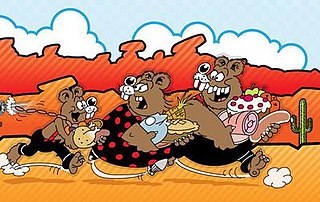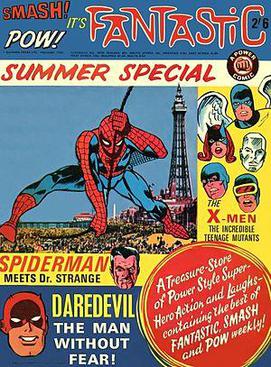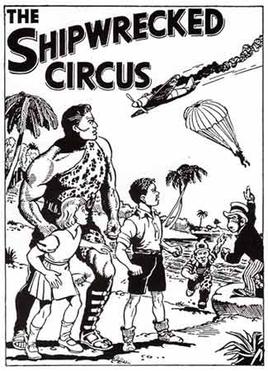The Beano is a British anthology comic magazine created by Scottish publishing company DC Thomson. Its first issue was published on 30 July 1938, and it published its 4000th issue in August 2019. Popular and well-known comic strips and characters include Dennis the Menace, Minnie the Minx, The Bash Street Kids, Roger the Dodger, Billy Whizz, Lord Snooty and His Pals, Ivy the Terrible, General Jumbo, Jonah, and Biffo the Bear.
Joseph Leo Baxendale was an English cartoonist and publisher. Baxendale wrote and drew several titles. Among his best-known creations are the Beano strips Little Plum, Minnie the Minx, The Bash Street Kids, and The Three Bears.

The Three Bears was a long-running British comic strip which appeared in the British comics magazine The Beano. It first featured in 1959's issue 881 and ran sporadically until 2011 through reprints and several artists.

A British comic is a periodical published in the United Kingdom that contains comic strips. It is generally referred to as a comic or a comic magazine, and historically as a comic paper. As of 2014, the three longest-running comics of all time were all British.
Robert Nixon was an artist who worked on several British comics.
Ken Reid (1919–1987) was a British comic artist and writer, best known as the co-creator of Roger the Dodger and Jonah for The Beano and Faceache for Jet.
Shiver and Shake was a British comic magazine published every Monday by IPC Magazines Ltd. It ran from 10 March 1973 to 5 October 1974, when it merged with Whoopee! As often happens with British comics, many names of strips were a play on popular television programmes and films of the time. The theme of the strips were mainly horror ; similar to the later Monster Fun; indeed, Frankie Stein appeared in both comics.
Tom Paterson is a Scottish comic artist who drew characters for Fleetway in 1973–1990, and D.C Thomson from 1986 to 2012. As of 2013, he currently draws strips for Viz.

"Grimly Fiendish" is a single by English rock band the Damned, released on 18 March 1985.

Valiant was a weekly British comics periodical published by Fleetway Publications and later IPC Magazines from 4 October 1962 to 16 October 1976. A boys' adventure comic, it debuted numerous memorable characters, including Captain Hurricane, The Steel Claw and Mytek the Mighty. Valiant lasted for 712 issues before being merged with stablemate Battle Picture Weekly.

Pow! was a weekly British comic book published by Odhams Press' Power Comics imprint in 1967 and 1968. Like other Power Comics, Pow! featured a mixture of British strips with reprints from American Marvel Comics, including Spider-Man, Nick Fury, Agent of SHIELD and the Fantastic Four.

Fantastic was a weekly British comic book magazine published by Odhams Press under the Power Comics imprint. It first appeared on 18 February 1967, and with its 52nd issue on 10 February 1968 it merged with its sister title Terrific. The 89th and final issue of Fantastic appeared on 26 October 1968, after which it was merged into its sister title Smash!.

Terrific was a weekly British comic published by Odhams Press' Power Comics imprint in 1967–1968. Terrific was similar in format to its sister title Fantastic, which had started publication two months earlier. The two titles were quite unlike other British comics of the time, consisting mainly of material reprinted from American Marvel Comics, serving as an introduction to many of Marvel's superhero characters. In this respect, Fantastic and Terrific can be considered precursors of the Marvel UK weeklies such as The Mighty World of Marvel that appeared beginning in 1972.

Smash! was a weekly British comic book, published initially by Odhams Press and subsequently by IPC Magazines, from 5 February 1966 to 3 April 1971. After 257 issues it merged into Valiant.

Power Comics was an imprint of the British comics publisher Odhams Press that was particularly notable for its use of material reprinted from American Marvel Comics. Appearing chiefly during the years 1967 and 1968, the Power Comics line consisted of five weekly titles: Wham!, Smash!, Pow!, Fantastic and Terrific. The first three of these titles were essentially traditional The Beano-style British comics papers, supplemented by a small amount of Marvel and DC Comics material, while Fantastic and Terrific were more magazine-like in style and were dominated by their Marvel superhero content.

Paddy Brennan is an Irish comics artist who worked mainly in the UK, drawing adventure strips for D. C. Thomson & Co. titles. He was a freelancer, working six months of the year in Dublin and six months in London.
Grimly Feendish is a British comic book character created by Leo Baxendale in 1964, who originated in Baxendale's comic strip Eagle-Eye, Junior Spy, published in the magazine Wham! He is Eagle-Eye's nemesis and functions as a creepy but amusing comic book villain. The character became so popular that between 1966 and 1969 he had his own spin-off strip, Grimley Feendish in Smash!

Odhams Press was a British publishing company, operating from 1920 to 1968. Originally a magazine publisher, Odhams later expanded into book publishing and then children's comics. The company was acquired by Fleetway Publications in 1961 and then IPC Magazines in 1963. In its final incarnation, Odhams was known for its Power Comics line of titles, notable for publishing reprints of American Marvel Comics superheroes.
Brian Moncrieff Lewis was a British science fiction illustrator, comics artist, and animator. In the 1950s, he illustrated covers for pulp magazines like New Worlds, Science Fantasy, and Science Fiction Adventures. In the 1960s, he drew adventure comic strips for Tiger, Boys' World, Hurricane, and Eagle. He also used a more cartoony style to draw humor comic strips for Wham!, Smash, Cor!!, and Buster. In the 1970s, Lewis focused on comics adaptations of television and horror film properties.

Thunder was a weekly British comics periodical published by Fleetway Publications from 17 October 1970 to 13 March 1971. A boys' adventure comic, the title only lasted for 22 editions before being merged with another Fleetway title, the long-established Lion.












